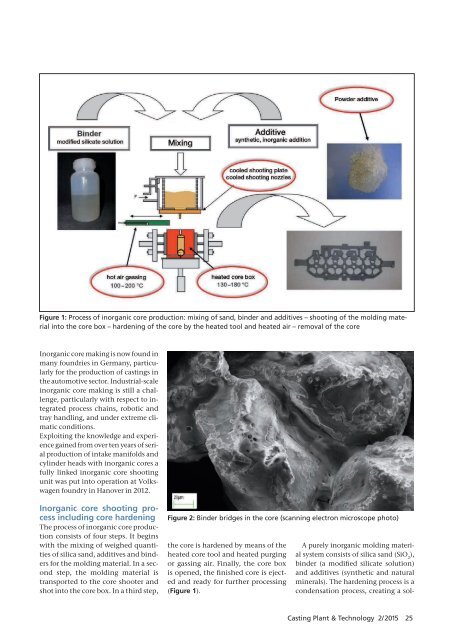CPT International 02/2015
The leading technical journal for the global foundry industry – Das führende Fachmagazin für die weltweite Gießerei-Industrie
The leading technical journal for the
global foundry industry – Das führende Fachmagazin für die
weltweite Gießerei-Industrie
You also want an ePaper? Increase the reach of your titles
YUMPU automatically turns print PDFs into web optimized ePapers that Google loves.
Figure 1: Process of inorganic core production: mixing of sand, binder and additives – shooting of the molding material<br />
into the core box – hardening of the core by the heated tool and heated air – removal of the core<br />
Inorganic core making is now found in<br />
many foundries in Germany, particularly<br />
for the production of castings in<br />
the automotive sector. Industrial-scale<br />
inorganic core making is still a challenge,<br />
particularly with respect to integrated<br />
process chains, robotic and<br />
tray handling, and under extreme climatic<br />
conditions.<br />
Exploiting the knowledge and experience<br />
gained from over ten years of serial<br />
production of intake manifolds and<br />
cylinder heads with inorganic cores a<br />
fully linked inorganic core shooting<br />
unit was put into operation at Volkswagen<br />
foundry in Hanover in 2012.<br />
Inorganic core shooting process<br />
including core hardening<br />
The process of inorganic core production<br />
consists of four steps. It begins<br />
with the mixing of weighed quantities<br />
of silica sand, additives and binders<br />
for the molding material. In a second<br />
step, the molding material is<br />
transported to the core shooter and<br />
shot into the core box. In a third step,<br />
Figure 2: Binder bridges in the core (scanning electron microscope photo)<br />
the core is hardened by means of the<br />
heated core tool and heated purging<br />
or gassing air. Finally, the core box<br />
is opened, the finished core is ejected<br />
and ready for further processing<br />
(Figure 1).<br />
A purely inorganic molding material<br />
system consists of silica sand (SiO 2<br />
),<br />
binder (a modified silicate solution)<br />
and additives (synthetic and natural<br />
minerals). The hardening process is a<br />
condensation process, creating a sol-<br />
Casting Plant & Technology 2/<strong>2015</strong> 25


















